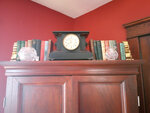

During the recent COVID-19-driven Zoom revolution, we often watched talking heads discuss serious issues from their homes. To emphasize their gravitas, many of them showcased book collections as backdrops.
There were the usual suspects, like “The Power Broker,” by Robert A. Caro, which could always be singled out due to its immense size. Some went as far as arranging their books by color: yellow, then red, then blue, like an American flag.
Using books as decorative ornaments is not a new phenomenon. Politicians and academics have been showcasing their book collections since the beginning of the printed word. Nothing says “I’m important and smart” like a collection of leather-bound tomes. You can easily find portraits of political leaders like Winston Churchill and major industrialists like J.P. Morgan with their libraries in the background.
There are numerous works, like “Decorating with Books,” by Marie Proeller Hueston, and “Bibliostyle: How We Live at Home with Books,” by Nina Freudenberger and Sadie Stein, that teach readers how and where to use books as props.
Etsy is a popular website to search for decorating tips and book collections. A recent ad listed a few dozen books for $45.56. Vinyl stick-on wallpaper with books as the centerpiece, which can be purchased online for less than $10, has also become popular in recent years.
Favored among decorators are the handsome leather-bound books of Franklin Library and Easton Press.
Some book backdrops can be pure fun, like a collection of “Nancy Drew” or “The Hardy Boys” novels with the spines pointing out. Just don’t be like the United Kingdom politician who got caught a few years ago with a photoshopped image of books as a backdrop.
Recent articles in The New York Times and The Wall Street Journal reported on the timeless trend of using books as décor.
In the Wall Street Journal article “Houses Without Tomes Aren’t Homes,” Faith Bottum wrote, “I know we live differently without physical books. They define space with their repository of words. They catch the eye and beckon the imagination.”
Interior decorators have long known about books’ ability to catch the eye. Leaf through any of the major decorating magazines and you’ll find an array of coffee-table books displayed in modern living rooms. They speak volumes about the owner’s tastes and predilections.
Anna Kodé covered the trend of using fake books as décor in an April New York Times article. She included examples that are pretty over the top, like the 20,000 fake books used in the background of a Netflix production or wedding venues that contain only fake books. Locally, the Graduate hotel in East Lansing has a lobby wall decorated with real books.
In her extensive article, Kodé expounded how film and television sets that display books as a backdrop inspire the use of fake books in homes.
Despite most legal research now being done online, you’ll occasionally still see television ads for lawyers featuring a library of law books displayed on a wall of bookcases. A few years ago, I helped someone dispose of 1,000 law books, which ended up at a community theater. No one else wanted them.
Book readers often become book decorators by default, displaying their collections of Hemingway, Faulkner or complete runs of James Lee Burke mysteries for guests to peruse. The meticulous ones arrange their books by date of publication or themes like architecture or art. Readers are also apt to stack books sideways on a shelf.
In her article, Kodé quoted an English professor who said the use of fake books can be traced to the Gilded Age. Writer and designer Edith Wharton depicted “new money” as buying fake books and equated it with poor taste.
For those who want to decorate indiscriminately, a web search will turn up a wide range of sites selling books by the yard, by the foot, by themes or even by color.
Better yet, buy local by visiting estate sales. Lists of them, sorted by locale, can be found at estatesales.com. At these sales, you can purchase leather-bound volumes — both pristine and well-used — for very cheap, with the added bonus that you don’t have to pay shipping costs.
If you’d like to get started building your own eye-catching book collection, begin with a visit to the Library of Michigan’s Martha W. Griffiths Michigan Rare Book Room or the University of Michigan’s Bentley Historical Library and William L. Clements Library. These troves of beautifully displayed books are sure to inspire you to transform a corner of your home into a library you love.
Support City Pulse - Donate Today!
Comments
No comments on this item Please log in to comment by clicking here